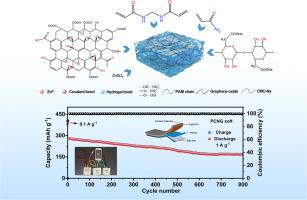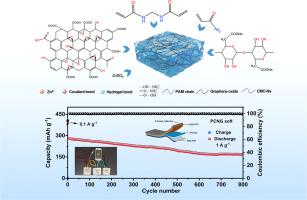Graphene enhanced hydrogel electrolyte boost flexible zinc ion battery stability
IF 5.6
3区 材料科学
Q1 ELECTROCHEMISTRY
引用次数: 0
Abstract
Conventional aqueous zinc-ion batteries face challenges such as hydrogen evolution and dendrite growth, leading to poor cycling stability. To address these issues, we develop a composite hydrogel electrolyte (PCNG) with a water-poor solvation structure by integrating graphene oxide (GO) and sodium carboxymethyl cellulose (CMC–Na) into a polyacrylamide (PAM) matrix. The PCNG electrolyte utilizes a multi-hydrogen-bond network to effectively confine free water molecules, significantly suppressing zinc anode corrosion and side reactions while achieving high ionic conductivity (45.5 mS cm−1). The Zn||Zn symmetric cell employing PCNG demonstrates exceptional stability over 1000 hours at 0.2 mA cm−2. Furthermore, the three-dimensional cross-linked structure of PCNG endows it with outstanding mechanical flexibility. When paired with a graphene oxide/sodium vanadate (G@NVO) cathode, the flexible pouch cell retains a high capacity of 167.8 mAh g−1 after 800 cycles at 1.0 A g−1 and maintains functionality under extreme mechanical stress (e.g., bending and puncture), highlighting its potential for flexible energy storage applications. This work proposes an innovative design strategy for flexible zinc-ion batteries that harmonizes high ionic conductivity, interfacial stability, and dendrite suppression.


石墨烯增强水凝胶电解质提高柔性锌离子电池的稳定性
传统的水性锌离子电池面临着析氢和枝晶生长等挑战,导致循环稳定性差。为了解决这些问题,我们通过将氧化石墨烯(GO)和羧甲基纤维素钠(CMC-Na)整合到聚丙烯酰胺(PAM)基质中,开发了一种具有疏水溶剂化结构的复合水凝胶电解质(PCNG)。PCNG电解质利用多氢键网络有效地限制自由水分子,显著抑制锌阳极腐蚀和副反应,同时实现高离子电导率(45.5 mS cm⁻¹)。采用PCNG的Zn||锌对称电池在0.2 mA cm⁻²下表现出超过1000小时的优异稳定性。此外,PCNG的三维交联结构使其具有优异的机械柔韧性。当与氧化石墨烯/钒酸钠(G@NVO)阴极配对时,柔性袋状电池在1.0 ag⁻¹的800次循环后保持167.8 mAh的高容量,并在极端机械应力(例如弯曲和刺穿)下保持功能,突出了其柔性储能应用的潜力。这项工作提出了一种柔性锌离子电池的创新设计策略,该策略协调了高离子电导率,界面稳定性和枝晶抑制。
本文章由计算机程序翻译,如有差异,请以英文原文为准。
求助全文
约1分钟内获得全文
求助全文
来源期刊

Electrochimica Acta
工程技术-电化学
CiteScore
11.30
自引率
6.10%
发文量
1634
审稿时长
41 days
期刊介绍:
Electrochimica Acta is an international journal. It is intended for the publication of both original work and reviews in the field of electrochemistry. Electrochemistry should be interpreted to mean any of the research fields covered by the Divisions of the International Society of Electrochemistry listed below, as well as emerging scientific domains covered by ISE New Topics Committee.
 求助内容:
求助内容: 应助结果提醒方式:
应助结果提醒方式:


